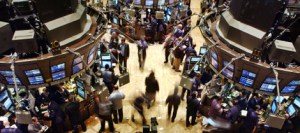 March 11, 2025
March 11, 2025
What You Need to Know Today:
Job growth in January slower but still steady
The U.S. economy added 143,000 jobs in January, a slower but solid pace that was a tick below economist forecasts. The unemployment rate dipped to 4%. The labor market slowed compared to December. That December report was revised Friday to show 307,000 jobs gained that month. Average hourly wage growth accelerated, rising by 4.1% rate over the past 12 months. That wage gain was above the rate of inflation.

Happy New Year!!!
Happy 2025! All the best for 2025. May the year be prosperous–and safe.

S&P 500 finishes up 23% in 2024
Despite ending 2024 with a serie of losing sessions–four down sessions in a row–the Standard & Poor’s 500 finished up 23% in 2024.

Pending home sales climb again. Is this another negative sign for 2025?
Pending sales of U.S. homes increased for a fourth month in November to the highest level since early 2023. But why? That’s the key question. If it’s because potential buyers have given up waiting for the Federal Reserve to cut interest rates further, then this “good news” is another negative indicator for 2025

Saturday Night Quarterback says (on a Sunday), For the week ahead expect…
We’re edging closer to a decisive either/or moment for stocks in 2025 on interest rates and earnings.

Buon Natale from Venice
Do you know how to tell it’s Christmas here in Venice?

Special Report It’s a New World for Dividend Income Investors Pick #5 Visa
Bookkeeping. I added Visa as Pick #5 for my New World of Dividend Investors Special Report (You can find it in the Special Report section of this site along with all the content on this market and its trends for Dividend Income investors. But I’m reposting it as a stand alone pick so no one misses it.
Live Market Report (20 minute delay)

Special Report New World of Dividend Investing Pick #6 Honeywell
Bookkeeping. I added Honeywell (HON) as Pick #6 for my New World for Dividend Investing Special Report (You can find it in the Special Report section of this site along with all the content on this market and its trends for Dividend Income investors. But I’m reposting it as a stand alone pick so no one misses it.

Please Watch My New YouTube Video: Quick Pick Modena
Today's Quick Pick is Moderna (MRNA). Moderna is the somewhat controversial MRNA vaccine developer that saw shares and sales soar from the company's development of a messenger RNA COVID Vaccine. Now that the pandemic (or at least worries over the pandemic) has...

Manufacturing report raises fears on when, how often the Fed will cut interest rates
Could it be just two interest rate cuts in 2024 instead of three (or four as the most bullish wish)? The Institute for Supply Management’s manufacturing index showed U.S. factory activity unexpectedly expanding in March for the first time since September 2022 on a sharp rebound in production and stronger demand. Even worse, for those counting on early and often cuts from the Fed, input costs, AKA inflation, climbed.

First quarter surprise: Tech didn’t lead the market
The results are in. And, surprise the technology sector didn’t lead the market in the first quarter. In fact the 8.8% gain for the Technology Select Sector SPDR ETF (XLK), which tracks the S&P 500’s information technology sector, trailed the 10% gain for the Standard & Poor’s 500 index. And several other sectors outperformed the XLK ETF.

Saturday Night Quarterback says, For the week ahead expect…
Maybe no one ever expects the Spanish Inquisition, but we all know by now to expect the monthly jobs report to be a big deal for this market. On Friday, April 5, the Bureau of Labor Statistics will report on nonfarm payrolls for March. Economists expect 216,000 nonfarm jobs to have been added in March.

Special Report It’s a New World for Dividend Income Investors Pick #5 Visa
Bookkeeping. I added Visa as Pick #5 for my New World of Dividend Investors Special Report (You can find it in the Special Report section of this site along with all the content on this market and its trends for Dividend Income investors. But I’m reposting it as a stand alone pick so no one misses it.

Please Watch My New YouTube Video: Tech CEOs Calling a Top in This Market?
Today’s video is Tech CEOs Calling a Top in This Market? The Financial Times just did a story about tech CEOs insider buying and selling. During the first quarter of 2024, the ratio of insider selling vs. insider buying has climbed to heights not seen since the first quarter of 2021. Amazon’s CEO Jeff Bezos, sold about $135 million of Amazon stock and Peter Thiel, cofounder of Palantir Technologies, sold $175 million worth of stock in March. Why? There could be a few reasons for these sales. During the rally at the end of 2023, many investors put off selling until 2024 to delay capital gains taxes and we’re seeing that selling demand now. Additionally, these tech CEOs have tremendous amounts of their wealth tied up in one asset, and in order to diversify, they must sell some of those shares. But CEOs could be selling because they feel this market is near a top. The fear that we’re in a bubble like that in the dot com era has been nagging investors and these sales by tech CEOs are contributing to that fear. I think we’re likely to be still a year or more away from a top in this rally. I don’t expect to start to hear a negative narrative about AI until 2025 or 2026. New technology takes a while to work through the system and I think around 2025-2026 companies will notice that their new AI technologies haven’t yet produced the returns they hoped on the schedule they imagined and the market will start to react. That will be the time for a sell off. And for long term investors to buy on any excessive selling, (Remember how long it took before the massive investment in PCs started to drop to bottom lines.) In the meantime, I don’t see a bubble popping in 2024 and while this news from tech CEOs doesn’t make me feel better, I do think it’s important to recognize that tech CEOs have reasons to sell now that don’t have much of anything do with your portfolio’s risk portfolio.

Apple shareholders looking at an even more volatile six months–buy, sell, or hold (and when)
Apple is likely to take its shareholders on an even wilder ride in the next six months than they’ve been on since the December all-time high at $199.62. The end result, I think is likely to be a renewed rally beginning in the fall–if you can either hold on through the volatility until then or see your way clear to timing when to buy and sell.

Special Report A New World for Dividend Investors Pick #4 Equinor
Equinor (EQNR) is Pick #4 in my Special Report A New World for Dividend Investors. I posted this pick in my long Special Report post. But I wanted to flag it here as well so no one wouldl miss the pick. Dividend Pick #4: Equinor (EQNR)

Special Report A New World for Dividend Investors Pick #3 Nike
Bookkeeping. I made Nike Pick No. 3 in my Special Report A New World for Dividend Investors. You can find the pick and write up i nmy long Special Report post. But I wanted to flag the pick here so no one would miss it. Dividend Pick #3: Nike (NKE)

Counter-counter-attack from Viking Therapeutics in the GLP-1 diabetes/weight loss drug war
First, it was Viking Therapeutics (VKTX) on the attack with trial results that shows its GLP-1 dibetes/weight loss drug out performing current leader of the pack drugs fro Novo Nordisk (NVO) and Eli Lilly (LLY). On the news Viking soared.
Then Novo Nordisk struct back with data of its own showing progress on an oral formulation of its rugs. (All existing GLP-1 drugs are delivered by injection.) That cratered Viking Shares. Now, March 26, Viking has released new Phase 1 trial data from a multiple ascending dose study of the oral version of VK2735, a dual agonist of the glucagon-like peptide 1 (GLP-1) and glucose-dependent insulinotropic polypeptide (GIP) receptors.

Please Watch My New YouTube Video: Hot Button Moves NOW Buy CMG
Today’s Hot Button Moves NOW video is Buy Chipotle Mexican Grill (CMG). Chipotle announced it will be spitting 50 to 1. With the stock , currently trading at $2800 the split will bring in a new group of investors. The stock popped about 3.5% the day following the announcement and continued to go up in the following days. It’s contrary to modern capital market theory that a stock announcing a split should go up, but it does need happen. Chipotle has a great long term story. It not only survived the COVID pandemic, but the company drove its digital loyalty membership up to 36 million people and added digital drive-thru lanes, leading to extraordinary growth. Chipotle had a 38% increase in earnings in 2023 and an 8% increase in comparable store sales. That, along with a 26% operating margin, continues to make Chipotle one o the most compelling consumer stocks to own,. I think owning this before the split, which will likely be approved in June, will get you appreciation from the pop on the split, as well as long term gains from this well-run company. Tomorrow I’ll be adding these shares to my lot-term 50 Stocks Portfolio.

Special Report: A New World for Dividends Pick #2 BEPC
Bookkeeping. I added this pick to my long Special Report post. I just want to make sure no one missed it. Dividend pick No.2: Brookfield Renewable Corp. (BEPC)

Special Report: New World for Dividends Pick #1 Pfizer
Bookkeeping. I added Pfizer as the first of 10 picks in my Special Report A New World for Dividends. You can find this write up on that long Special Reports post. But I want to make no one misses that pick and update.

Please Watch My New YouTube Video: Quick Pick Digital Realty Trust
Today’s Quick Pick is Digital Realty Trust (DLR). This dividend stock, currently pays at 3.46% (previously a bit higher) but the stock has done well on price appreciation too. This is a different way to play the AI boom–by investing in the data center realty space. Data centers are the hottest part of the real estate market at the moment and AI data center capacity is likely to double in the next 6-10 years. Digital Realty has about 300 data centers worldwide with 40 million square feet of rentable space. They recently made a deal with Brookfield in order to raise more capital to build out more facilities and expand their business. The stock is up only about 5.6% year to date which isn’t great if you’re looking at the AI boom. It is up 43% over the last year but recent guidance from the company disappointed investors. The “meh” stock performance recently marks a good time to get in on a stock that has good dividends and a potential for capital appreciation when growth picks up again. The stock has been a member of my Dividend Portfolio since March 16, 2019. The shares are up 161% since then as of March 25.
Saturday Night Quarterback says, For the week ahead expect…
The week will bring lots of important news on inflation and on the auto sectors and from Adobe on developments in AI. With some strange wrinkles in timing due to the short Good Friday schedule.

Please Watch My New YouTube Video: What Powell Said and What the Market Heard
Today’s video is What Powell Said, and What the Market Heard. Jerome Powell, Chair of the Federal Reserve, tried to walk a fine line during Wednesday’s press conference. He said that while inflation is sticky; he’s still confident in a soft landing at 2.0% and that they will cut rates once they confirm that a 2.0% rate is achievable. What the market heard was “we can tolerate higher inflation for longer while still cutting rates, ” and this is backed up by the Fed’s Dot Plot economic projections . The Dot Plot lays out 2-3 cuts in 2024 even though core PCE inflation rates are expected to be at 2.6% at the end of the year–not the target of 2.0%. That 2.0% target will now not likely be reached until the end of 2026, the Fed’s own economic projections say. The market reacted to the news that they heard as “the Fed is no longer insisting on the 2.0% target and will be cutting rates this year,” by hitting its 20th all-time high for 2024. The market heard happy days are here again, and rallied.

Hey, Federal Reserve! What about the real world like, oh, wages?
You know the saying, When all you have is a hammer, every problem looks like a nail? How about this data world version, When you don’t track the data, you can’t see the problem? I was drawn to paraphrase the classic hammer/nail adage by the release of the Federal Reserve’s most recent economic projections, the Dot Plot, on Wednesday, March 20 when I thought about the economic data the Fed didn’t include in its projections.

Initial claims for unemployment drop for the week
Initial claims for state unemployment benefits dropped 2,000 to a seasonally adjusted 210,000 for the week ended March 16, the Labor Department reported today, March 21. Economists polled by Reuters had forecast 215,000 claims in the latest week. Continuing claims for unemployment increased 4,000 to 1.807 million during the week ending March 9, the report on Thursday showed. The Federal Reserve has been looking for signs that the labor market is weakening before raising interest rates. So far the evidence is inconclusive.

No surprise! on interest rates from the Federal Reserve today
The Federal Reserve unanimously voted to leave the benchmark Fed Funds rate in a range of 5.25% to 5.5%, the highest since 2001, for a fifth straight meeting. They left their projections in the quarterly Dot Plot for the Fed Funds rate by the end of 2024 at 4.6%. That was the same projection as in the December Dot Plot. And nothing in either the post-meeting press statement or in Fed chair Jerome Powell’s press remarks changed the timing on when the Fed will make its first interest rate cut.



